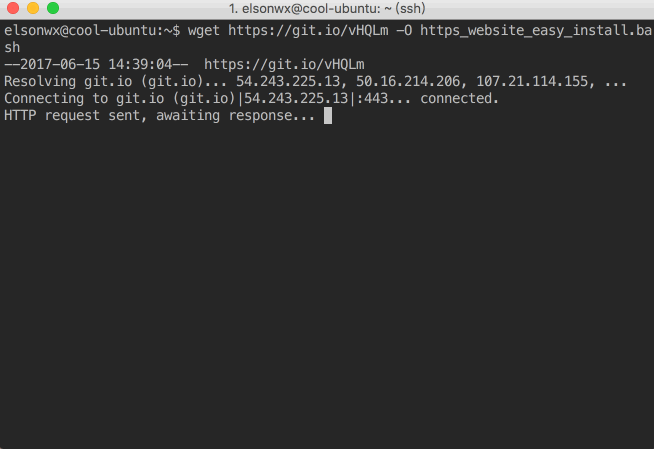one command to generate https website on Nginx.All you need to do is input your domain names and set your web directory according the terminal prompt.
- Port 80 and port 443 have been allowed in your server's firewall rule.
-
Step 1: install Nginx on Linux
-
Ubuntu/Debian
sudo apt-get update && sudo apt-get -y install nginx -
Centos/Redhat
sudo yum -y update && sudo yum -y install nginx
-
-
Step 2: download this script
wget https://git.io/vHQLm -O https_website_easy_install.bash
-
Step 3: generate https website on your linux server
sudo bash https_website_easy_install.bash
-
This script will set a cron task to update the certificate on the 01:01 am of the random day of every month,so you do not have to worry about the free certificate would be expired.
-
If you just want to generate a http website,you can download the
http_website_easy_install.bashinstead.wget https://git.io/vQfud -O http_website_easy_install.bash
-
Some cloud platform's loading balance service has a key length limit,e.g. Google Cloud loading balance only support RSA-2048.So if you want to deploy the ssl certificate on the loading balance.You can modify the key length before running this script.
sed -i 's/4096/2048/g' https_website_easy_install.bash -
If you want to use chinese domain,you need to convert chinese domain to punycode,then when you are asking to input the domain name by this script, just input the punycode.e.g.https://王祥.我爱你,the punycode is
xn--qbyu8j.xn--6qq986b3xl
-
The SELinux mode may be opened in centos/redhat 6.6 and later,you will fail in the first step to establish a http website.You can check whether the SELinux is enabled in your server through execute
sestatus -vcommand.this error can be solved by closing the SELinux simply,you can close the SELinux and restart your serversudo sed -i 's/SELINUX=enforcing/SELINUX=disabled/g' /etc/selinux/config sudo init 6or you can solve this problem through these solutions
https://stackoverflow.com/a/26228135
https://www.nginx.com/blog/nginx-se-linux-changes-upgrading-rhel-6-6/#gs.iz_rbNA
-
you should enable the EPEL(Extra Packages for Enterprise Linux) repository or install nginx by other ways.
-
-
Vultr CentOS7 firewalls
https://www.vultr.com/docs/using-firewalld-to-manage-your-firewall-on-centos-7
firewall-cmd --zone=public --add-port=80/tcp --permanent firewall-cmd --zone=public --add-port=443/tcp --permanent systemctl restart firewalld -
AWS EC2 Security Groups
http://docs.aws.amazon.com/AWSEC2/latest/UserGuide/using-network-security.html
-
Google Cloud Firewall rules
-
Aliyun Security Groups
https://help.aliyun.com/document_detail/25471.html?spm=5176.100241.0.0.SK8N6Y
-
